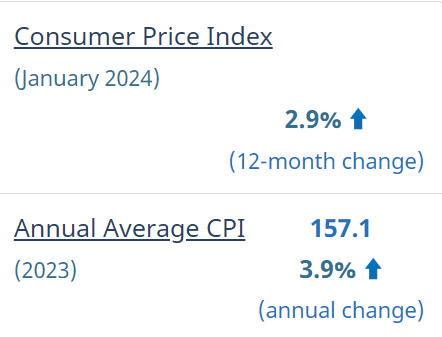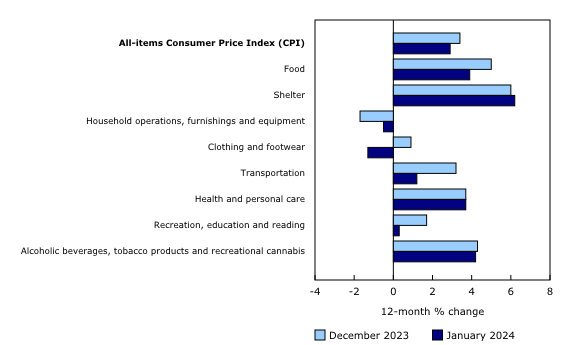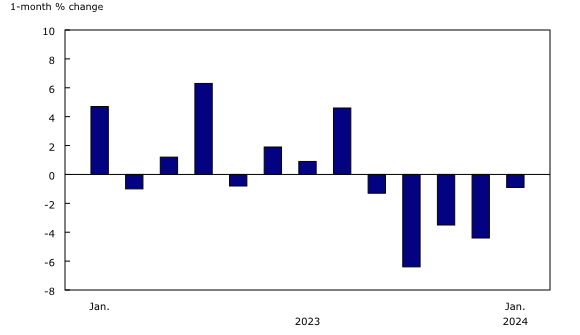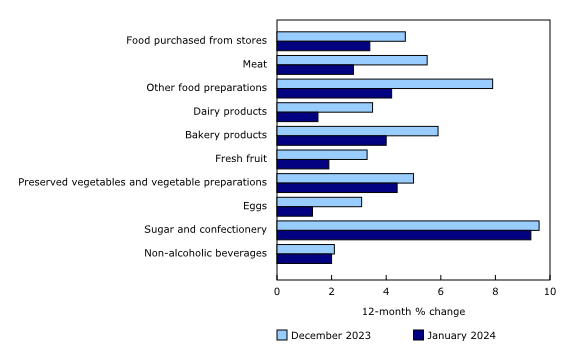January CPI Rose 2.9% vs 3.4% in December

Price growth for food purchased from stores slowed year over year in January (+3.4%) compared with December (+4.7%),

Statistics Canada Report- The Consumer Price Index (CPI) rose 2.9% on a year-over-year basis in January, following a 3.4% gain in December. The largest contributor to headline deceleration was lower year-over-year prices for gasoline in January (-4.0%) compared with December (+1.4%). Excluding gasoline, headline CPI slowed to 3.2% year over year in January, down from the 3.5% growth in December.
Price growth for food purchased from stores slowed year over year in January (+3.4%) compared with December (+4.7%), putting downward pressure on the all-items CPI. Lower prices for airfares and travel tours also contributed to the headline deceleration. For complete analysis, click here: https://www.statcan.gc.ca/en/subjects-start/prices_and_price_indexes/consumer_price_indexes
On a monthly basis, the CPI was unchanged in January, following a 0.3% decline in December. On a seasonally adjusted monthly basis, the CPI fell 0.1% in January, the first decline since May 2020.
Chart 1
12-month change in the Consumer Price Index (CPI) and CPI excluding gasoline


Chart 2
Five of the eight CPI components decelerate in January


Gasoline prices decline
Year over year, gasoline prices fell 4.0% in January following a 1.4% increase in December, largely due to a base-year effect. In January 2023, prices at the pump increased amid refinery closures in the southwestern United States following Winter Storm Elliott.
On a monthly basis, prices for gasoline fell in January 2024 (-0.9%) for the fifth consecutive month. Lower gas prices in Manitoba (-14.1%) contributed to the national decline, following a temporary suspension of the provincial gas tax.
Chart 3
Gasoline prices fall for the fifth consecutive month


Grocery prices increase at a slower pace
While grocery prices remained elevated, their growth slowed year over year in January (+3.4%) compared with December (+4.7%).
The deceleration of grocery prices was broad-based, with products such as meat (+2.8%), other food preparations (+4.2%), dairy products (+1.5%), bakery products (+4.0%) and fresh fruit (+1.9%) contributing to the slower year-over-year price growth in January. Other food items, such as soup (-2.1%), bacon (-8.4%) and shrimps and prawns (-3.4%) had year-over-year price declines in January.
Chart 4
Price growth slows for most grocery items in January


Consumers pay less for airfares
Prices for airfares declined in January (-14.3%) compared with December (-9.7%) on a year-over-year basis.
On a monthly basis, prices fell in January (-23.7%) compared with December (+31.1%). Airfares typically decline in January as heightened holiday demand subsides.
Explore the Consumer Price Index tools
Check out Statistics Canada's new Food Price Data Hub, which features a variety of food price related statistics, articles and tools.
Check out the Personal Inflation Calculator. This interactive calculator allows you to enter dollar amounts in the common expense categories to produce a personalized inflation rate, which you can compare to the official measure of inflation for the average Canadian household—the CPI.
Browse the Consumer Price Index Data Visualization Tool to access current (Latest Snapshot of the CPI) and historical (Price trends: 1914 to today) CPI data in a customizable visual format.
Canadians pay more for cellular services in January compared with December.
On a year-over-year basis, prices for cellular services fell 16.4% in January following a 26.8% decline in December.
On a monthly basis, prices rose 6.7% in January compared with December, as prices returned to earlier levels following promotions offered in November and December.
